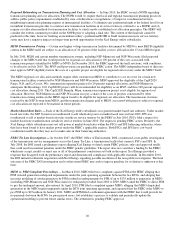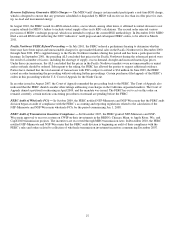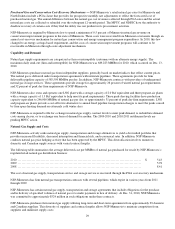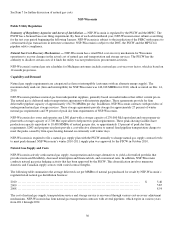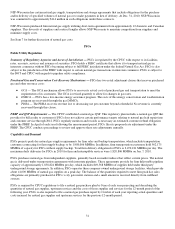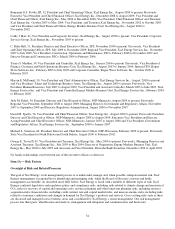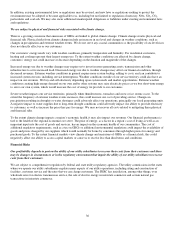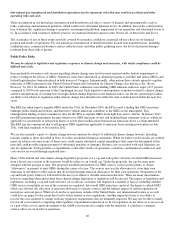Xcel Energy 2010 Annual Report Download - page 40
Download and view the complete annual report
Please find page 40 of the 2010 Xcel Energy annual report below. You can navigate through the pages in the report by either clicking on the pages listed below, or by using the keyword search tool below to find specific information within the annual report.30
See Item 7 for further discussion of natural gas costs.
NSP-Wisconsin
Public Utility Regulation
Summary of Regulatory Agencies and Areas of Jurisdiction — NSP-Wisconsin is regulated by the PSCW and the MPSC. The
PSCW has a biennial base-rate filing requirement. By June of each odd-numbered year, NSP-Wisconsin must submit a rate filing
for the test year period beginning the following January. NSP-Wisconsin is subject to the jurisdiction of the FERC with respect to
certain natural gas transactions in interstate commerce. NSP-Wisconsin is subject to the DOT, the PSCW and the MPSC for
pipeline safety compliance.
Natural Gas Cost-Recovery Mechanisms — NSP-Wisconsin has a retail PGA cost-recovery mechanism for Wisconsin
operations to recover changes in the actual cost of natural gas and transportation and storage services. The PSCW has the
authority to disallow certain costs if it finds the utility was not prudent in its procurement activities.
NSP-Wisconsin’s natural gas rate schedules for Michigan customers include a natural gas cost-recovery factor, which is based on
12-month projections.
Capability and Demand
Natural gas supply requirements are categorized as firm or interruptible (customers with an alternate energy supply). The
maximum daily send-out (firm and interruptible) for NSP-Wisconsin was 146,018 MMBtu for 2010, which occurred on Dec. 14,
2010.
NSP-Wisconsin purchases natural gas from independent suppliers, generally based on market indices that reflect current prices.
The natural gas is delivered under transportation agreements with interstate pipelines. These agreements provide for firm
deliverable pipeline capacity of approximately 134,736 MMBtu per day. In addition, NSP-Wisconsin contracts with providers of
underground natural gas storage services. These storage agreements provide storage for approximately 27 percent of winter
natural gas requirements and 39 percent of peak day firm requirements of NSP-Wisconsin.
NSP-Wisconsin also owns and operates one LNG plant with a storage capacity of 270,000 Mcf equivalent and one propane-air
plant with a storage capacity of 2,700 Mcf equivalent to help meet its peak requirements. These peak-shaving facilities have
production capacity equivalent to 18,408 MMBtu of natural gas per day, or approximately 13 percent of peak day firm
requirements. LNG and propane-air plants provide a cost-effective alternative to annual fixed pipeline transportation charges to
meet the peaks caused by firm space heating demand on extremely cold winter days.
NSP-Wisconsin is required to file a natural gas supply plan with the PSCW annually to change natural gas supply contract levels
to meet peak demand. NSP-Wisconsin’s winter 2010-2011 supply plan was approved by the PSCW in October 2010.
Natural Gas Supply and Costs
NSP-Wisconsin actively seeks natural gas supply, transportation and storage alternatives to yield a diversified portfolio that
provides increased flexibility, decreased interruption and financial risk, and economical rates. In addition, NSP-Wisconsin
conducts natural gas price hedging activity that has been approved by the PSCW. This diversification involves numerous
domestic and Canadian supply sources with varied contract lengths.
The following table summarizes the average delivered cost per MMBtu of natural gas purchased for resale by NSP-Wisconsin’s
regulated retail natural gas distribution business:
2010 ................................................................................................ $5.46
2009 ................................................................................................ 5.85
2008 ................................................................................................ 8.54
The cost of natural gas supply, transportation service and storage service is recovered through various cost-recovery adjustment
mechanisms. NSP-Wisconsin has firm natural gas transportation contracts with several pipelines, which expire in various years
from 2011 through 2032.








